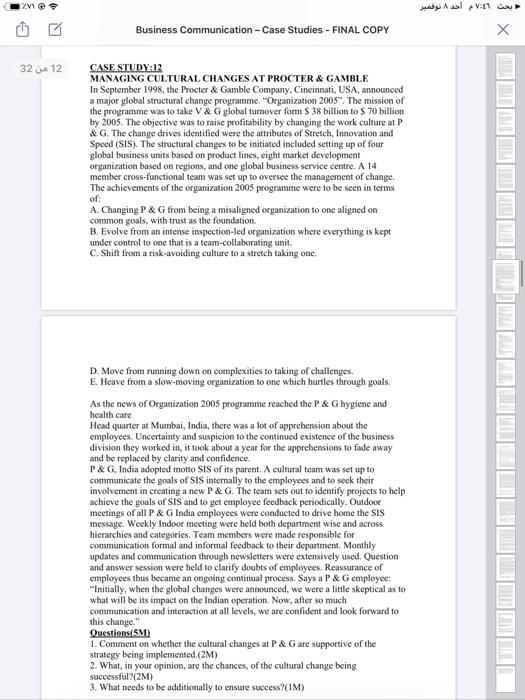7:46 Business Communication - Case Studies - FINAL COPY 32 12 CASE STUDYA? MANAGING CULTURAL CHANGES AT PROCTER & GAMBLE In September 1998, the Procter & Gamble Company, Cincinnati, USA, announced a major global structural change programme. Organization 2005" The mission of the programme was to take V&G global tumover for $ 38 billion to 70 billion by 2005. The objective was to raise profitability by changing the work culture at P & G. The change drives identified were the attributes of Stretch, Innovation and Speed (SIS). The structural changes to be initiated included setting up of four global business units based on product lines, eight market development organization based on regions, and one global business service centre. A 14 member cross-functional team was set up to oversee the management of change, The achievements of the organization 2005 programme were to be seen in terms of: A. Changing P&G from being a misaligned organization to one aligned on common goals, with trust as the foundation, B. Evolve from an intense inspection-led organization where everything is kept under control to one that is a team-collaborating unit. C. Shift from a risk-avoiding culture to a stretch taking one. D. Move from running down on complexities to taking of challenges. E. Heave from a slow-moving organization to one which hurtles through goals. As the news of Organization 2005 programme reached the P & G hygiene and health care Head quarter at Mumbai, India, there was a lot of apprehension about the employees. Uncertainty and suspicion to the continued existence of the business division they worked in, it took about a year for the apprehensions to fade away and be replaced by clarity and confidence. P&G, India adopted motto SIS of its parent. A cultural team was set up to communicate the goals of SIS internally to the employees and to seek their involvement in creating a new P&G. The team sets out to identify projects to help achieve the goals of SIS and to get employee feedback periodically. Outdoor meetings of all P&G India employees were conducted to drive home the SIS message. Weekly Indoor meeting were held both department wise and across hierarchies and categories. Team members were made responsible for communication formal and informal feedback to their department. Monthly updates and communication through newsletters were extensively used. Question and answer session were held to clarify doubts of employees. Reassurance of employees thus became an ongoing continual process. Says a P&G employee: "Initially, when the global changes were announced, we were a little skeptical as to what will be its impact on the Indian operation. Now, after so much communication and interaction at all levels, we are confident and look forward to this change." Questions SMD 1. Comment on whether the cultural changes at P & Gare supportive of the strategy being implemented.(2M) 2. What, in your opinion, are the chances of the cultural change being successful? (2M) 3. What needs to be additionally to ensure success?(IM) 7:46 Business Communication - Case Studies - FINAL COPY 32 12 CASE STUDYA? MANAGING CULTURAL CHANGES AT PROCTER & GAMBLE In September 1998, the Procter & Gamble Company, Cincinnati, USA, announced a major global structural change programme. Organization 2005" The mission of the programme was to take V&G global tumover for $ 38 billion to 70 billion by 2005. The objective was to raise profitability by changing the work culture at P & G. The change drives identified were the attributes of Stretch, Innovation and Speed (SIS). The structural changes to be initiated included setting up of four global business units based on product lines, eight market development organization based on regions, and one global business service centre. A 14 member cross-functional team was set up to oversee the management of change, The achievements of the organization 2005 programme were to be seen in terms of: A. Changing P&G from being a misaligned organization to one aligned on common goals, with trust as the foundation, B. Evolve from an intense inspection-led organization where everything is kept under control to one that is a team-collaborating unit. C. Shift from a risk-avoiding culture to a stretch taking one. D. Move from running down on complexities to taking of challenges. E. Heave from a slow-moving organization to one which hurtles through goals. As the news of Organization 2005 programme reached the P & G hygiene and health care Head quarter at Mumbai, India, there was a lot of apprehension about the employees. Uncertainty and suspicion to the continued existence of the business division they worked in, it took about a year for the apprehensions to fade away and be replaced by clarity and confidence. P&G, India adopted motto SIS of its parent. A cultural team was set up to communicate the goals of SIS internally to the employees and to seek their involvement in creating a new P&G. The team sets out to identify projects to help achieve the goals of SIS and to get employee feedback periodically. Outdoor meetings of all P&G India employees were conducted to drive home the SIS message. Weekly Indoor meeting were held both department wise and across hierarchies and categories. Team members were made responsible for communication formal and informal feedback to their department. Monthly updates and communication through newsletters were extensively used. Question and answer session were held to clarify doubts of employees. Reassurance of employees thus became an ongoing continual process. Says a P&G employee: "Initially, when the global changes were announced, we were a little skeptical as to what will be its impact on the Indian operation. Now, after so much communication and interaction at all levels, we are confident and look forward to this change." Questions SMD 1. Comment on whether the cultural changes at P & Gare supportive of the strategy being implemented.(2M) 2. What, in your opinion, are the chances of the cultural change being successful? (2M) 3. What needs to be additionally to ensure success?(IM)







